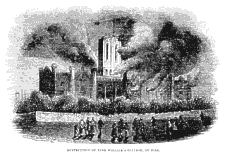
[ILN 27 Jan 1844]
We regret to record the almost total destruction of this splendid college edifice at Castletown by fire, on Sunday morning last. The fire was discovered about two o’clock, issuing from the school-room, and had already made such progress, that efforts to arrest it, without aid of engines, were wholly ineffectual. Engines were sent for to Douglas, without delay ; but, such was the distance, that before they arrived, the interior of the main building was wholly destroyed. Nothing is saved of that fine edifice but the bare walls, and a part of the east wing in which the Vice- Principal resides ; the very valuable library of the College, containing many works of great rarity, and a curious collection of Bibles, from the time of Coverdale, in upwards of fifty different languages, many unique MSS. relating to Manx ecclesiastical affairs, and the very valuable military models and plans, maps, mathematical and other instruments, many of which cannot be replaced without much labour and expence, belonging to Mr. Browne, the Professor of English and modern literature, were completely destroyed.
The first alarm was given by two boys who were sick of the measles, separated from the other boys, and sleeping immediately over the English class-rooms, who, having perceived a strong smell of fire, gave the alarm. There were about sixty boys sleeping within the college at the time, who were obliged to escape in their night shirts, but not a single accident occurred. The conduct of Mr. Dixon, the Principal, on this trying occasion, entitles him to the highest praise: his first care was to see that the lives of those entitled to his guardian-ship were all safe-—then he bestowed his attention on saving property to the utmost of his power.
King William’s College is a modern erection, about half a mile N.E. from Castletown. The first stone was laid by the late Lieut.Governor Smelt, on the 23d of April, 1830, and it was opened in the summer of 1833. The building is partly in the early English, and partly in the Elizabethan style, forming a spacious and cruciform structure, 210 feet in length from east to west, and 135 feet fromsi north to south ; from the intersection rose the embattled tower, 115 feet high, strengthened with buttresses, and surmounted by an octagonal turret, intended for an observatory, having in each of its sides an elegant amid lofty window, and crowned with a parapet. The edifice cost about £6000, of which £2000 was from the accumulated fund from property granted by Bishop Barrow, in 1668, for the education of young men for the ministry in the Manx Church. From subscriptions, raised chiefly in the island, £2000 was obtained, and the remaining £2000 was supplied by mortgaging the funds. The original draught of the design was furnished by Messrs. Hanson and Welsh, architects ; but the execution of the works, including the alterations and additions, and the design for the great tower—a beautiful specimen of masonry—were under the direction of Mr. Welsh. The contractor was the late Mr. Fitzsimmons, who, it is said, lost £1500 by the contract. The property is vested in the hands of trustees, who are the Lieutenant-Governor, the Lord Bishop, the Clerk of the Rolls, the Archdeacon, Deemster Christian, one Vicar-General, and the Attorney-General. The funds expended in the erection of the edifice were, we believe, aided by generous benefactions from England.
|
|
||
|
Any comments, errors or omissions
gratefully received The
Editor |
||